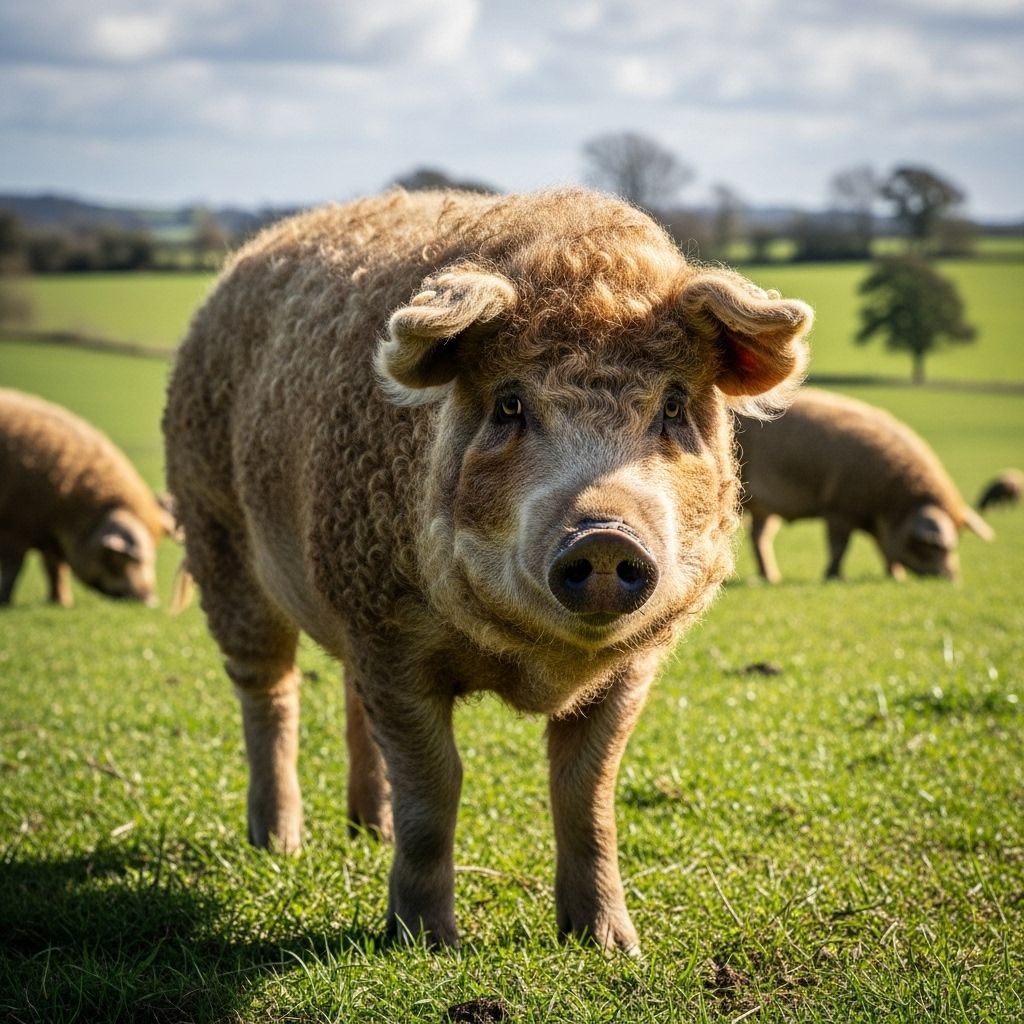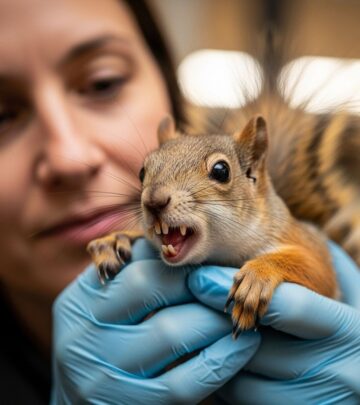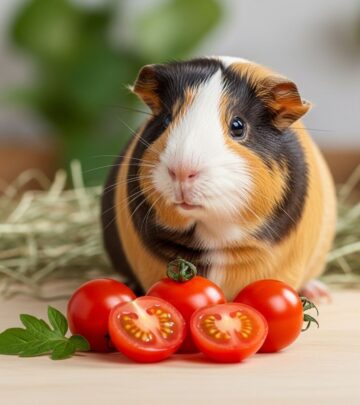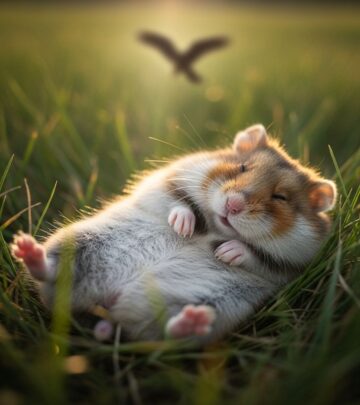Furry Mangalitsa Pigs: The Unlikely Sheep of the Swine World
These curly-coated swine pair resilience with melt-in-your-mouth, gourmet-worthy meat.

Image: HearthJunction Design Team
If you’ve ever looked out over a farm pasture and suddenly paused, thinking you’ve seen sheep only to blink and realize those woolly creatures are actually pigs, chances are you’ve encountered the Mangalitsa—the curly-coated pig breed sometimes lovingly dubbed the “sheep pig.” These unique swine are famous for their wild, sheep-like coats and rich history, captivating animal lovers, farmers, and foodies alike.
What Are Mangalitsa Pigs?
The Mangalitsa pig (sometimes spelled Mangalica or Mangalitza) is a rare heritage breed originating from Hungary in the mid-19th century. Unlike the sleek, pink pigs that commonly come to mind, the Mangalitsa is instantly recognizable by its thick, curly hair—a trait shared only by one other now-extinct breed, the Lincolnshire Curly Coat from England[4].
Developed by crossbreeding native Hungarian pigs with wild boars and the Serbian Šumadija, these animals were prized both for their hardiness and their exceptional ability to produce high-quality lard[4].
The Famous Fleece: What Makes Mangalitsa Pigs Look Like Sheep?
- Curly, dense wool: Their thick, coiled hair grows especially lush during winter, resembling sheep’s fleece[1].
- Varied colors: The three most recognized types are Blonde, Red, and Swallow Belly (black with a white underside), but across all colorations, the curly wool is the breed’s defining feature[2].
- Seasonal shedding: Just like sheep, Mangalitsas molt their curly coat in the summertime, revealing a sometimes smoother, shorter layer until the cold returns[2].
The unique appearance is not just for show. This unusual fleece helps the Mangalitsa survive cold winters on the Hungarian plain, offering protection few other pig breeds naturally possess[1].
The History and Heritage of the Mangalitsa Breed
The story of the Mangalitsa is as curly as its coat. In 1833, Hungarian royalty sought to create a pig breed fit for their tables and adaptable to their wintry climate. The result was a robust, fatty pig with remarkable hair that could flourish outdoors year-round[2].
By the turn of the 20th century, Mangalitsa pigs became the dominant swine breed in Hungary, celebrated for their flavorful lard and unique meat. However, as agricultural tastes turned toward leaner pork products in the mid-1900s, Mangalitsas nearly disappeared, their population dropping precipitously.
Today, thanks to renewed interest in heritage animal breeds and artisanal foods, the Mangalitsa is experiencing a well-deserved renaissance, appreciated for both its woolly charm and exceptionally marbled meat.
Physical Traits and Breed Standards
The Mangalitsa is a medium-sized pig, generally with a short and deep body, and a fine but robust skeletal structure[2].
- Size: Females typically weigh 200–220 lbs (64–67 cm tall), while males reach 220–225 lbs (65–70 cm tall)[1].
- Coat: The iconic dense, curly coat appears strongest in winter, coiling into tight rings or tufts, and may thin or straighten in warm seasons[1].
- Color variations: The three primary color morphs are Blonde, Red, and Swallow Belly[2].
- Distinct features: The “Wellmann spot” (a bright spot on the lower edge of the ear, about an inch in diameter) is typical for all Mangalitsa pigs[2].
- Piglets: Young Mangalitsas often have striped coats which fade within the first few weeks of life[2].
| Trait | Description |
|---|---|
| Coat | Thick, curly, sheep-like; especially dense in winter |
| Color Types | Blonde, Red, Swallow Belly (black with a white belly) |
| Average Adult Weight | 200–225 lbs (90–102 kg) |
| Build | Medium-sized, deep body, strong skeleton |
| Lifespan | 10–12 years (when well cared for) |
| Litter Size | 6 piglets per litter on average |
The Friendly Nature of Mangalitsa Pigs
Beneath the thick coat lies a gentle disposition. Mangalitsa pigs are known for their affable temperament, making them easier to handle than many commercial pig breeds[1].
- Strong maternal instincts: Sows are attentive mothers and fiercely protective of their piglets[1].
- Calm demeanor: These pigs display remarkable resilience to stress and are generally less skittish than their leaner cousins.
- Hardiness: Adapted to low temperatures, they thrive outdoors with minimal shelter needs, provided their nutritional requirements are met.
Why Don’t All Pigs Have Curls?
The Mangalitsa’s iconic fleece is the result of intentional selective breeding for cold resistance and entailed heritage. Most modern pig breeds were developed for fast growth and high feed efficiency, qualities often incompatible with “woolly” coats. The only other comparable curly-covered breed, England’s Lincolnshire Curly Coat, became extinct in the 1970s[4].
The coat’s unusual appearance and practical advantage have given the Mangalitsa a lasting edge in specialty farming, but also led to their extraordinary visual charm, often resulting in social media fame as the “pig that looks like a sheep.”
Distinct Meat and Culinary Renown
Mangalitsa pigs are celebrated not only for their looks but also for their high-quality meat. Unlike the lean, mass-produced pork found in supermarkets, Mangalitsa meat is renowned for its:
- High intramuscular fat: Often referred to as “the Kobe beef of pork,” the fat provides marbling that makes the meat exceptionally juicy, tender, and flavorful[1].
- Healthier fat profile: The fat is richer in monounsaturated fatty acids, giving it a longer shelf life and offering a better omega-3 to omega-6 ratio compared to conventional pork fat or seed oils[1].
- Specialty uses: Mangalitsa pork is prized for fine hams, artisanal salamis, and gourmet charcuterie, especially in Hungary and Central Europe.
This exceptional pork commands a premium price and is increasingly found in specialty restaurants and butcher shops worldwide. Chefs applaud its “old world” richness, texture, and taste.
Color Varieties: Blonde, Red, and Swallow Belly
- Blonde: The most common type, with golden ringlets.
- Red: Displaying a rich russet or copper-tinted wool.
- Swallow Belly: Characterized by a black back and sides with a distinct white underbelly and legs[2].
Each coloration presents the same loveable curls and hardy constitution, but the diversity of colors adds to the breed’s distinctive appeal.
Breed Standards and Recognition
To maintain purity and distinctness, only truebred Mangalitsa pigs—with the expected physical features and fleece characteristics—are allowed in official registries[2].
- Forbidden traits: Disqualifying features include pink spots on the belly, legs, or nose; black or brown spots; unpigmented body openings; pink nipples or more than twelve nipples; and pure white tails without the signature black tassel[3].
- Unique identifier: The “Wellmann spot” on the ear is a breed hallmark[2].
- Seasonal shedding: Expect pronounced molting as the hair thins in summer and grows back in winter[2].
Mangalitsa Piglets: Stripes and Surprises
At birth, Mangalitsa piglets often bear wild-looking stripes, reminiscent of the markings on wild boar piglets. These lively patterns fade as the piglets grow, replaced by the solid-colored, curly coats characteristic of adults[2].
This dramatic transition in appearance is just another way the Mangalitsa stands out among heritage livestock breeds.
Living With Mangalitsa: Care and Habitat
Keeping Mangalitsa pigs requires attention to both their housing and dietary needs, but their cold-hardiness and natural resistance to disease make them a favorite among small farmers and homesteaders.
- Environment: These pigs thrive with access to pasture, shelter for shade and inclement weather, and opportunity to root and forage.
- Feeding: While hardy, Mangalitsas need a balanced diet and plenty of forage for best health and optimal fleece growth.
- Social life: Mangalitsas are social, intelligent animals that benefit from companionship—preferably with other pigs or even sheep!
The Mangalitsa in Popular Culture and Farming Today
Once on the verge of extinction, Mangalitsa pigs now enjoy growing popularity both on hobby farms and in the hands of chefs eager for unique, flavorful pork. Their Instagram-ready looks and gentle personality have made them minor celebrities on social media and in animal sanctuaries worldwide.
Organizations dedicated to heritage breeds have been instrumental in preserving the Mangalitsa, ensuring these charming “woolly wonders” don’t disappear like their English cousins.
Quick Facts Table: Mangalitsa at a Glance
| Fact | Detail |
|---|---|
| Origin | Hungary, 19th century |
| Coat | Thick, curly, sheep-like |
| Primary Colors | Blonde, Red, Swallow Belly |
| Temperament | Calm, hardy, gentle |
| Meat Quality | Highly marbled, flavorful, and juicy |
Frequently Asked Questions (FAQs)
Q: Why do Mangalitsa pigs look so different from other pigs?
A: Their distinct, curly coat is a result of selective breeding for cold climates, giving them a sheep-like appearance that stands out from conventional slick-haired pig breeds.
Q: Are Mangalitsa pigs rare?
A: Yes. While they were once common in 19th-century Hungary, their numbers dramatically declined during the 20th century. However, recent conservation and breeding efforts are helping revive the population.
Q: Can you keep Mangalitsa pigs as pets?
A: Although mainly valued for their meat and lard, their friendly temperament makes them suitable for hobby farms and sanctuaries. They require space, companionship, and appropriate care.
Q: Is the meat from Mangalitsa pigs healthy?
A: The meat is highly marbled with a healthier fat profile, including more monounsaturated and omega-3 fatty acids than many other pork breeds, making it a favorite among chefs and health-conscious consumers.
Q: Do they really act like sheep?
A: Beyond appearances, Mangalitsa pigs don’t behave like sheep, but they share the same calm, flocking, and outdoor adaptability—making the nickname “sheep pig” as fitting for temperament as for looks.
Q: Are Mangalitsa pigs suitable for beginners?
A: Yes. Their robust constitution and affable nature make them viable for small-scale farming, provided you have the space and resources for outdoor pig husbandry.
Q: Where can I see a Mangalitsa pig?
A: Many heritage breed farms, agricultural fairs, and some petting zoos now showcase Mangalitsa pigs, along with some animal sanctuaries focused on preserving rare breeds.
Conclusion
The Mangalitsa pig is a true marvel of the farmyard—a throwback to a time when livestock was valued for character as well as utility. With their lush, curly coats, gentle natures, and unrivaled culinary reputation, Mangalitsas continue to enchant both those who raise them and anyone fortunate enough to glimpse or taste them. Whether viewed as “sheep in pig’s clothing” or simply as living agricultural treasures, these curly-haired pigs invite us to celebrate the diversity, history, and delight of heritage breeds in the modern world.
References
Read full bio of medha deb












